Analysis of Seclusion Practices in Australian Mental Healthcare
VerifiedAdded on 2022/09/01
|12
|3406
|25
Essay
AI Summary
This essay provides a comprehensive analysis of seclusion practices within the Australian mental healthcare system. It begins with an introduction to mental health challenges in Australia, highlighting the prevalence of mental illness and the use of involuntary treatment, restraint, and seclusion. The discussion examines the impacts of seclusion on both consumers and healthcare professionals, exploring negative emotions, potential misuse, and the effects on working conditions and stress levels. The role of registered nurses in mental healthcare is also discussed, emphasizing their responsibilities in planning, diagnosing, and supporting patients and other professionals. Furthermore, the essay outlines national initiatives aimed at improving mental health services, including government programs and legislative changes. The essay integrates contemporary literature and provides critical discussion on restrictive and coercive practices in mental health.
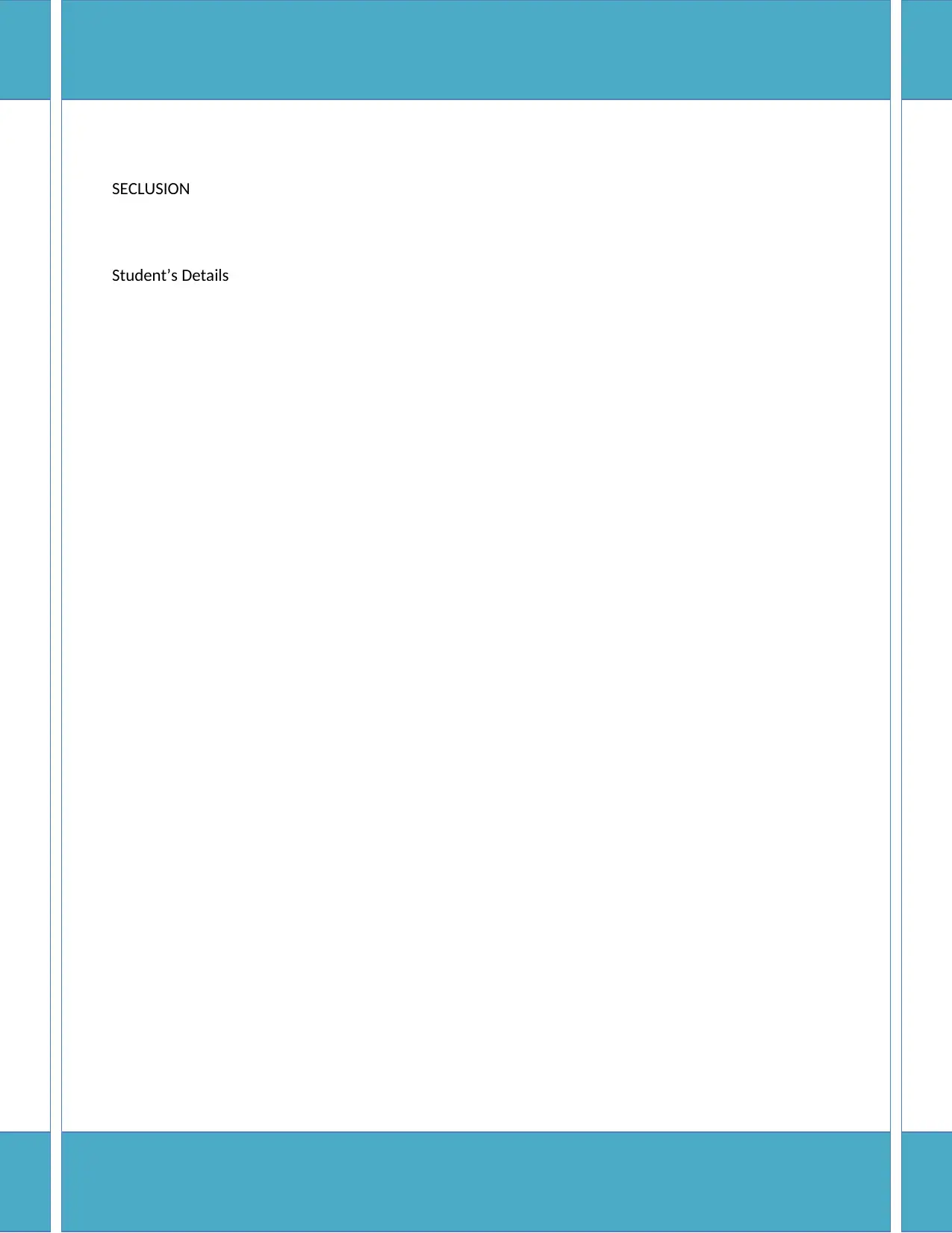
SECLUSION
Student’s Details
Student’s Details
Paraphrase This Document
Need a fresh take? Get an instant paraphrase of this document with our AI Paraphraser
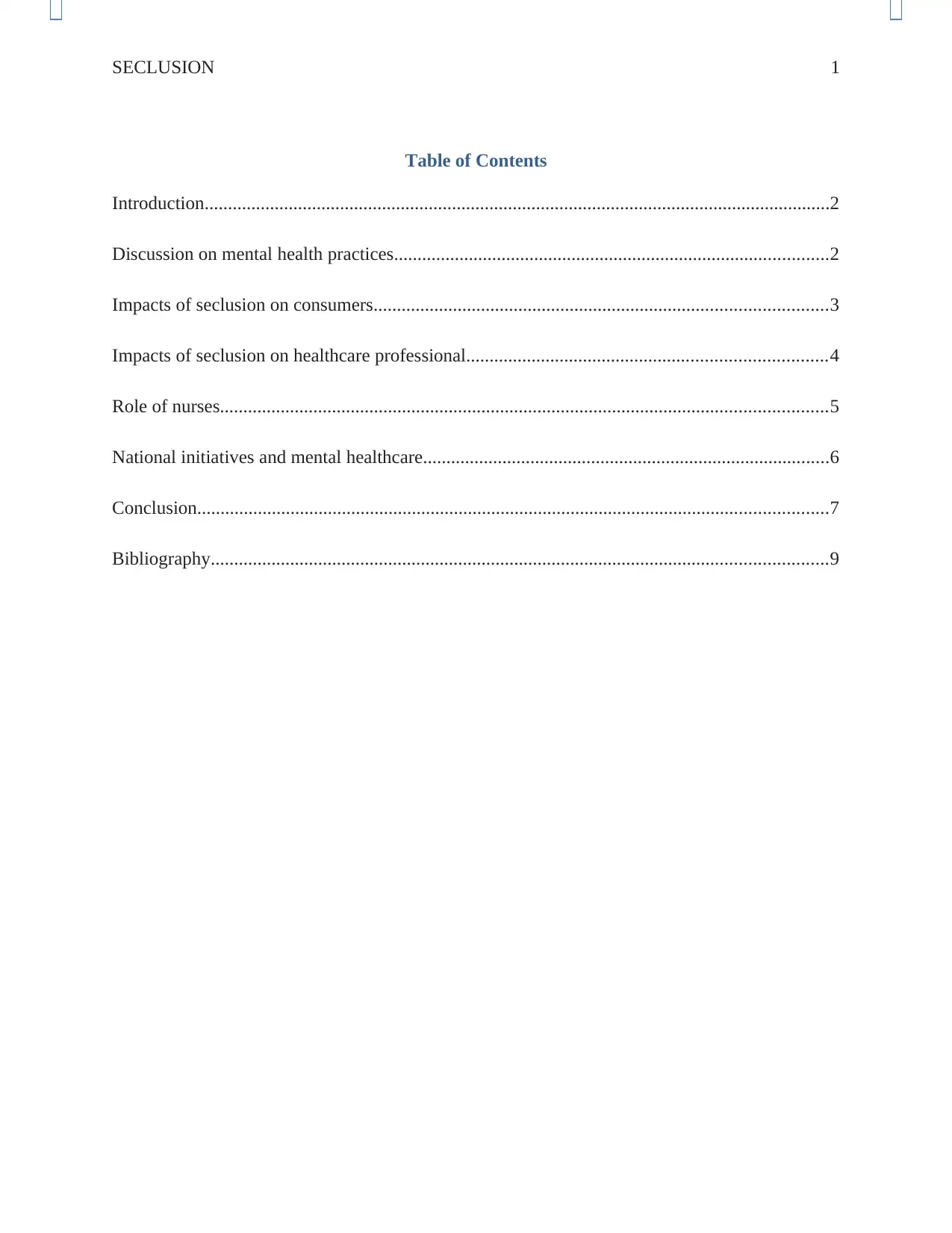
SECLUSION 1
Table of Contents
Introduction......................................................................................................................................2
Discussion on mental health practices.............................................................................................2
Impacts of seclusion on consumers.................................................................................................3
Impacts of seclusion on healthcare professional.............................................................................4
Role of nurses..................................................................................................................................5
National initiatives and mental healthcare.......................................................................................6
Conclusion.......................................................................................................................................7
Bibliography....................................................................................................................................9
Table of Contents
Introduction......................................................................................................................................2
Discussion on mental health practices.............................................................................................2
Impacts of seclusion on consumers.................................................................................................3
Impacts of seclusion on healthcare professional.............................................................................4
Role of nurses..................................................................................................................................5
National initiatives and mental healthcare.......................................................................................6
Conclusion.......................................................................................................................................7
Bibliography....................................................................................................................................9
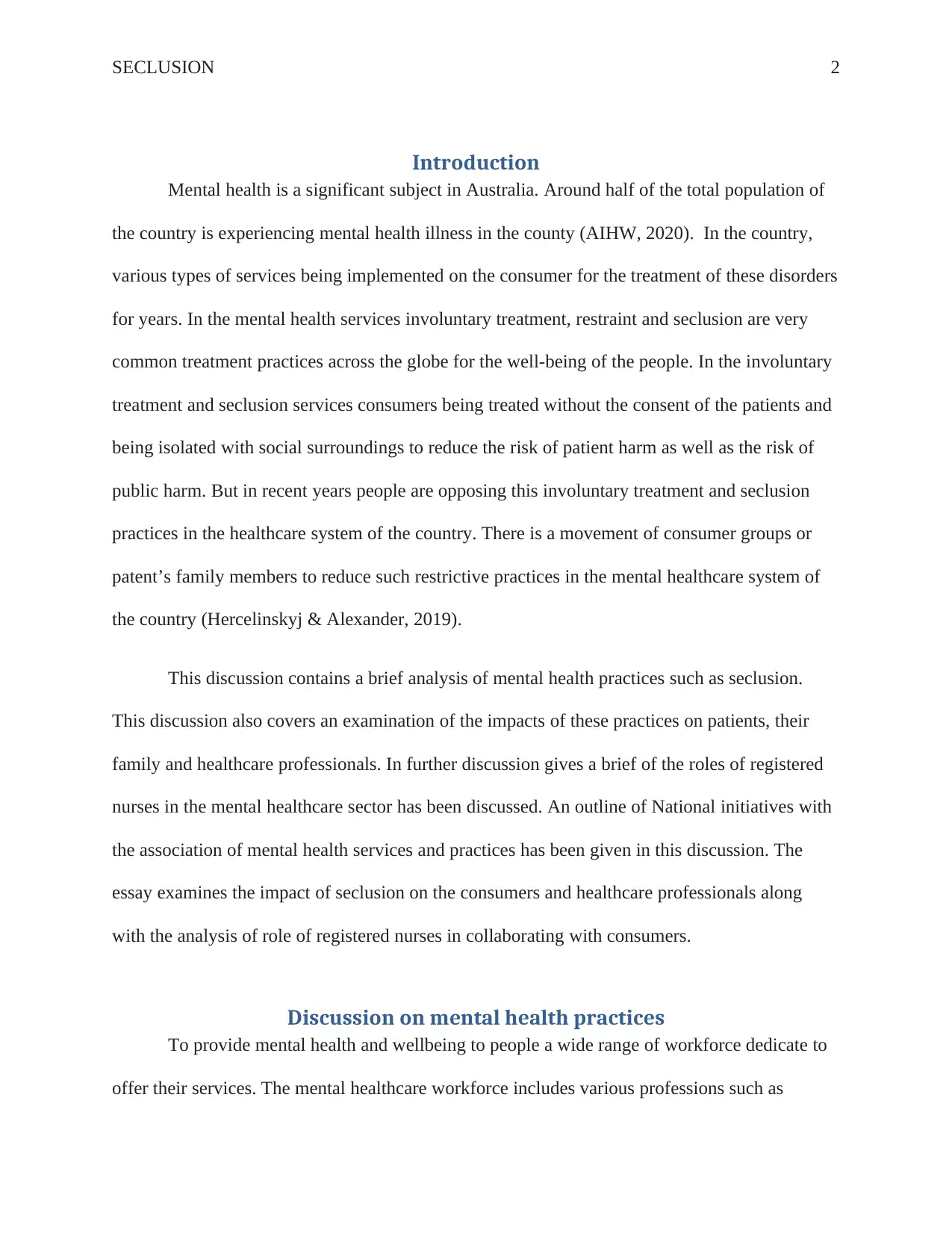
SECLUSION 2
Introduction
Mental health is a significant subject in Australia. Around half of the total population of
the country is experiencing mental health illness in the county (AIHW, 2020). In the country,
various types of services being implemented on the consumer for the treatment of these disorders
for years. In the mental health services involuntary treatment, restraint and seclusion are very
common treatment practices across the globe for the well-being of the people. In the involuntary
treatment and seclusion services consumers being treated without the consent of the patients and
being isolated with social surroundings to reduce the risk of patient harm as well as the risk of
public harm. But in recent years people are opposing this involuntary treatment and seclusion
practices in the healthcare system of the country. There is a movement of consumer groups or
patent’s family members to reduce such restrictive practices in the mental healthcare system of
the country (Hercelinskyj & Alexander, 2019).
This discussion contains a brief analysis of mental health practices such as seclusion.
This discussion also covers an examination of the impacts of these practices on patients, their
family and healthcare professionals. In further discussion gives a brief of the roles of registered
nurses in the mental healthcare sector has been discussed. An outline of National initiatives with
the association of mental health services and practices has been given in this discussion. The
essay examines the impact of seclusion on the consumers and healthcare professionals along
with the analysis of role of registered nurses in collaborating with consumers.
Discussion on mental health practices
To provide mental health and wellbeing to people a wide range of workforce dedicate to
offer their services. The mental healthcare workforce includes various professions such as
Introduction
Mental health is a significant subject in Australia. Around half of the total population of
the country is experiencing mental health illness in the county (AIHW, 2020). In the country,
various types of services being implemented on the consumer for the treatment of these disorders
for years. In the mental health services involuntary treatment, restraint and seclusion are very
common treatment practices across the globe for the well-being of the people. In the involuntary
treatment and seclusion services consumers being treated without the consent of the patients and
being isolated with social surroundings to reduce the risk of patient harm as well as the risk of
public harm. But in recent years people are opposing this involuntary treatment and seclusion
practices in the healthcare system of the country. There is a movement of consumer groups or
patent’s family members to reduce such restrictive practices in the mental healthcare system of
the country (Hercelinskyj & Alexander, 2019).
This discussion contains a brief analysis of mental health practices such as seclusion.
This discussion also covers an examination of the impacts of these practices on patients, their
family and healthcare professionals. In further discussion gives a brief of the roles of registered
nurses in the mental healthcare sector has been discussed. An outline of National initiatives with
the association of mental health services and practices has been given in this discussion. The
essay examines the impact of seclusion on the consumers and healthcare professionals along
with the analysis of role of registered nurses in collaborating with consumers.
Discussion on mental health practices
To provide mental health and wellbeing to people a wide range of workforce dedicate to
offer their services. The mental healthcare workforce includes various professions such as
⊘ This is a preview!⊘
Do you want full access?
Subscribe today to unlock all pages.

Trusted by 1+ million students worldwide
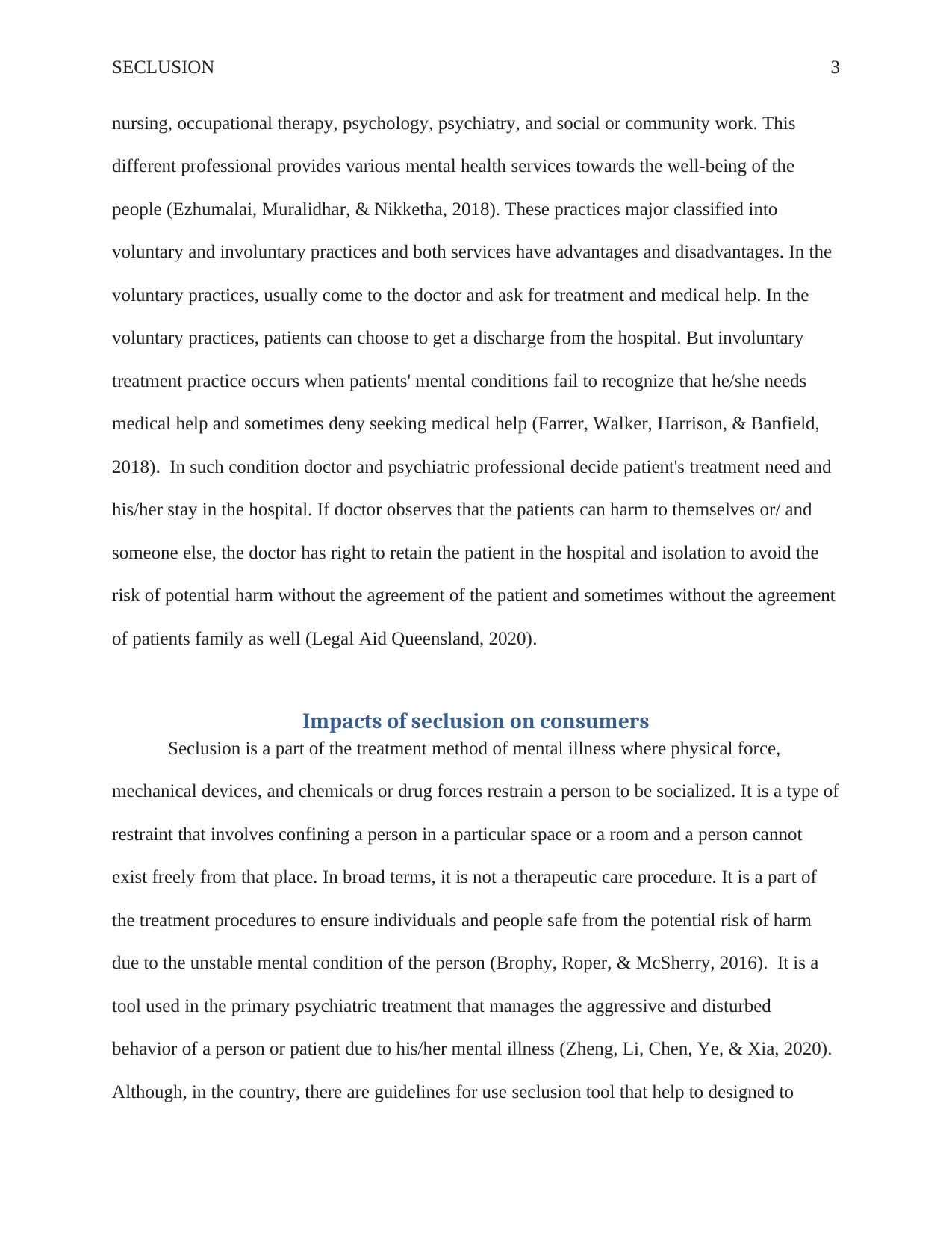
SECLUSION 3
nursing, occupational therapy, psychology, psychiatry, and social or community work. This
different professional provides various mental health services towards the well-being of the
people (Ezhumalai, Muralidhar, & Nikketha, 2018). These practices major classified into
voluntary and involuntary practices and both services have advantages and disadvantages. In the
voluntary practices, usually come to the doctor and ask for treatment and medical help. In the
voluntary practices, patients can choose to get a discharge from the hospital. But involuntary
treatment practice occurs when patients' mental conditions fail to recognize that he/she needs
medical help and sometimes deny seeking medical help (Farrer, Walker, Harrison, & Banfield,
2018). In such condition doctor and psychiatric professional decide patient's treatment need and
his/her stay in the hospital. If doctor observes that the patients can harm to themselves or/ and
someone else, the doctor has right to retain the patient in the hospital and isolation to avoid the
risk of potential harm without the agreement of the patient and sometimes without the agreement
of patients family as well (Legal Aid Queensland, 2020).
Impacts of seclusion on consumers
Seclusion is a part of the treatment method of mental illness where physical force,
mechanical devices, and chemicals or drug forces restrain a person to be socialized. It is a type of
restraint that involves confining a person in a particular space or a room and a person cannot
exist freely from that place. In broad terms, it is not a therapeutic care procedure. It is a part of
the treatment procedures to ensure individuals and people safe from the potential risk of harm
due to the unstable mental condition of the person (Brophy, Roper, & McSherry, 2016). It is a
tool used in the primary psychiatric treatment that manages the aggressive and disturbed
behavior of a person or patient due to his/her mental illness (Zheng, Li, Chen, Ye, & Xia, 2020).
Although, in the country, there are guidelines for use seclusion tool that help to designed to
nursing, occupational therapy, psychology, psychiatry, and social or community work. This
different professional provides various mental health services towards the well-being of the
people (Ezhumalai, Muralidhar, & Nikketha, 2018). These practices major classified into
voluntary and involuntary practices and both services have advantages and disadvantages. In the
voluntary practices, usually come to the doctor and ask for treatment and medical help. In the
voluntary practices, patients can choose to get a discharge from the hospital. But involuntary
treatment practice occurs when patients' mental conditions fail to recognize that he/she needs
medical help and sometimes deny seeking medical help (Farrer, Walker, Harrison, & Banfield,
2018). In such condition doctor and psychiatric professional decide patient's treatment need and
his/her stay in the hospital. If doctor observes that the patients can harm to themselves or/ and
someone else, the doctor has right to retain the patient in the hospital and isolation to avoid the
risk of potential harm without the agreement of the patient and sometimes without the agreement
of patients family as well (Legal Aid Queensland, 2020).
Impacts of seclusion on consumers
Seclusion is a part of the treatment method of mental illness where physical force,
mechanical devices, and chemicals or drug forces restrain a person to be socialized. It is a type of
restraint that involves confining a person in a particular space or a room and a person cannot
exist freely from that place. In broad terms, it is not a therapeutic care procedure. It is a part of
the treatment procedures to ensure individuals and people safe from the potential risk of harm
due to the unstable mental condition of the person (Brophy, Roper, & McSherry, 2016). It is a
tool used in the primary psychiatric treatment that manages the aggressive and disturbed
behavior of a person or patient due to his/her mental illness (Zheng, Li, Chen, Ye, & Xia, 2020).
Although, in the country, there are guidelines for use seclusion tool that help to designed to
Paraphrase This Document
Need a fresh take? Get an instant paraphrase of this document with our AI Paraphraser
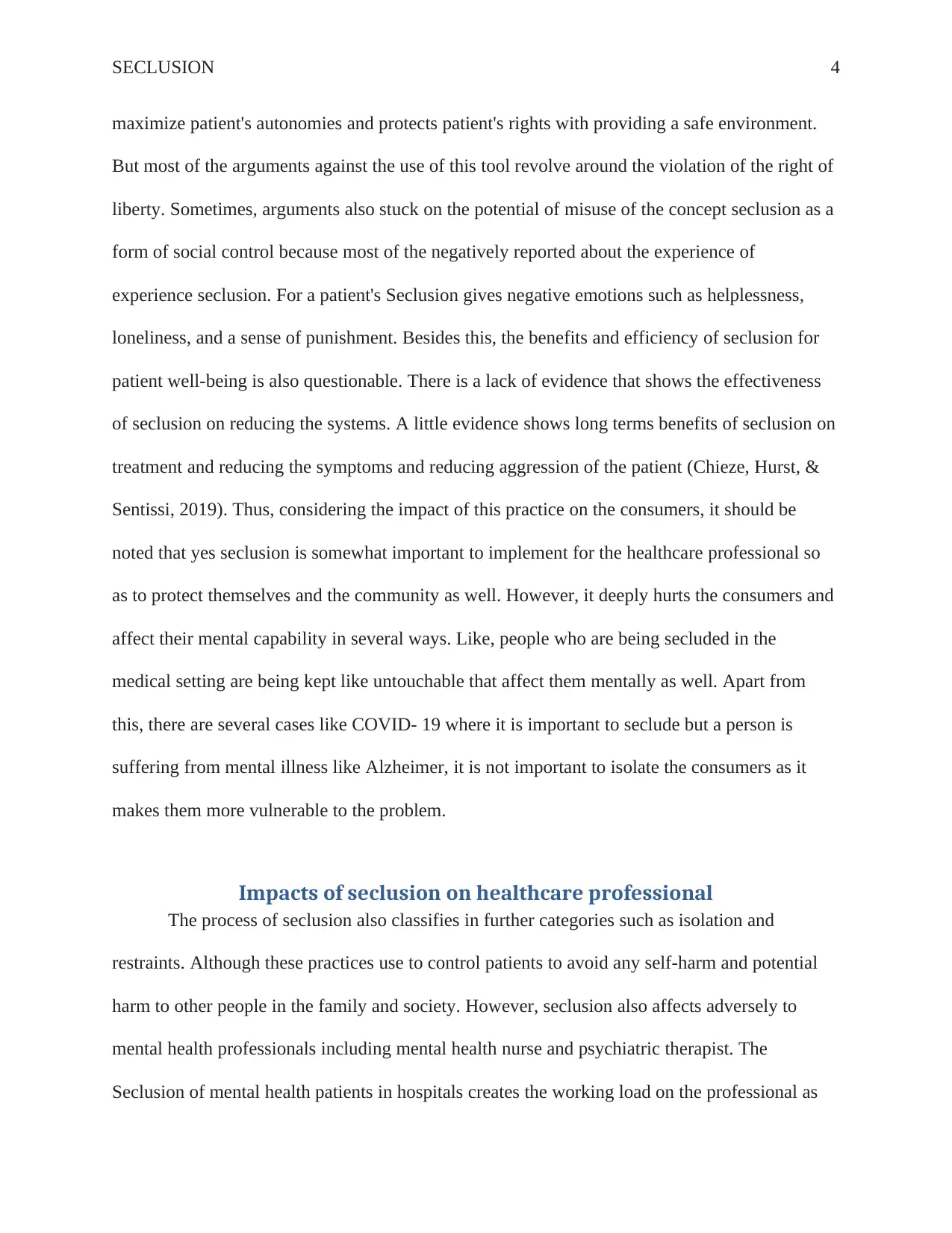
SECLUSION 4
maximize patient's autonomies and protects patient's rights with providing a safe environment.
But most of the arguments against the use of this tool revolve around the violation of the right of
liberty. Sometimes, arguments also stuck on the potential of misuse of the concept seclusion as a
form of social control because most of the negatively reported about the experience of
experience seclusion. For a patient's Seclusion gives negative emotions such as helplessness,
loneliness, and a sense of punishment. Besides this, the benefits and efficiency of seclusion for
patient well-being is also questionable. There is a lack of evidence that shows the effectiveness
of seclusion on reducing the systems. A little evidence shows long terms benefits of seclusion on
treatment and reducing the symptoms and reducing aggression of the patient (Chieze, Hurst, &
Sentissi, 2019). Thus, considering the impact of this practice on the consumers, it should be
noted that yes seclusion is somewhat important to implement for the healthcare professional so
as to protect themselves and the community as well. However, it deeply hurts the consumers and
affect their mental capability in several ways. Like, people who are being secluded in the
medical setting are being kept like untouchable that affect them mentally as well. Apart from
this, there are several cases like COVID- 19 where it is important to seclude but a person is
suffering from mental illness like Alzheimer, it is not important to isolate the consumers as it
makes them more vulnerable to the problem.
Impacts of seclusion on healthcare professional
The process of seclusion also classifies in further categories such as isolation and
restraints. Although these practices use to control patients to avoid any self-harm and potential
harm to other people in the family and society. However, seclusion also affects adversely to
mental health professionals including mental health nurse and psychiatric therapist. The
Seclusion of mental health patients in hospitals creates the working load on the professional as
maximize patient's autonomies and protects patient's rights with providing a safe environment.
But most of the arguments against the use of this tool revolve around the violation of the right of
liberty. Sometimes, arguments also stuck on the potential of misuse of the concept seclusion as a
form of social control because most of the negatively reported about the experience of
experience seclusion. For a patient's Seclusion gives negative emotions such as helplessness,
loneliness, and a sense of punishment. Besides this, the benefits and efficiency of seclusion for
patient well-being is also questionable. There is a lack of evidence that shows the effectiveness
of seclusion on reducing the systems. A little evidence shows long terms benefits of seclusion on
treatment and reducing the symptoms and reducing aggression of the patient (Chieze, Hurst, &
Sentissi, 2019). Thus, considering the impact of this practice on the consumers, it should be
noted that yes seclusion is somewhat important to implement for the healthcare professional so
as to protect themselves and the community as well. However, it deeply hurts the consumers and
affect their mental capability in several ways. Like, people who are being secluded in the
medical setting are being kept like untouchable that affect them mentally as well. Apart from
this, there are several cases like COVID- 19 where it is important to seclude but a person is
suffering from mental illness like Alzheimer, it is not important to isolate the consumers as it
makes them more vulnerable to the problem.
Impacts of seclusion on healthcare professional
The process of seclusion also classifies in further categories such as isolation and
restraints. Although these practices use to control patients to avoid any self-harm and potential
harm to other people in the family and society. However, seclusion also affects adversely to
mental health professionals including mental health nurse and psychiatric therapist. The
Seclusion of mental health patients in hospitals creates the working load on the professional as
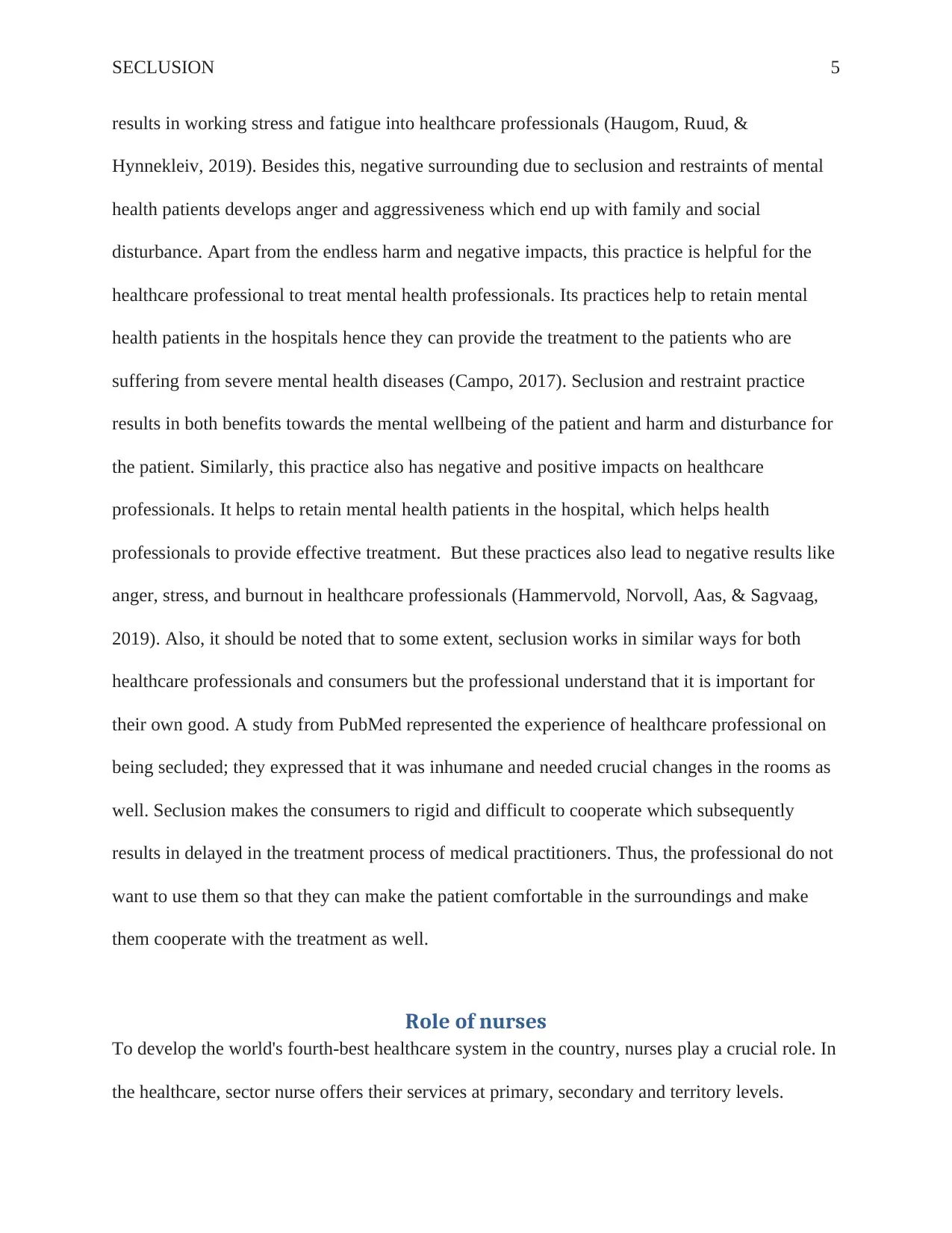
SECLUSION 5
results in working stress and fatigue into healthcare professionals (Haugom, Ruud, &
Hynnekleiv, 2019). Besides this, negative surrounding due to seclusion and restraints of mental
health patients develops anger and aggressiveness which end up with family and social
disturbance. Apart from the endless harm and negative impacts, this practice is helpful for the
healthcare professional to treat mental health professionals. Its practices help to retain mental
health patients in the hospitals hence they can provide the treatment to the patients who are
suffering from severe mental health diseases (Campo, 2017). Seclusion and restraint practice
results in both benefits towards the mental wellbeing of the patient and harm and disturbance for
the patient. Similarly, this practice also has negative and positive impacts on healthcare
professionals. It helps to retain mental health patients in the hospital, which helps health
professionals to provide effective treatment. But these practices also lead to negative results like
anger, stress, and burnout in healthcare professionals (Hammervold, Norvoll, Aas, & Sagvaag,
2019). Also, it should be noted that to some extent, seclusion works in similar ways for both
healthcare professionals and consumers but the professional understand that it is important for
their own good. A study from PubMed represented the experience of healthcare professional on
being secluded; they expressed that it was inhumane and needed crucial changes in the rooms as
well. Seclusion makes the consumers to rigid and difficult to cooperate which subsequently
results in delayed in the treatment process of medical practitioners. Thus, the professional do not
want to use them so that they can make the patient comfortable in the surroundings and make
them cooperate with the treatment as well.
Role of nurses
To develop the world's fourth-best healthcare system in the country, nurses play a crucial role. In
the healthcare, sector nurse offers their services at primary, secondary and territory levels.
results in working stress and fatigue into healthcare professionals (Haugom, Ruud, &
Hynnekleiv, 2019). Besides this, negative surrounding due to seclusion and restraints of mental
health patients develops anger and aggressiveness which end up with family and social
disturbance. Apart from the endless harm and negative impacts, this practice is helpful for the
healthcare professional to treat mental health professionals. Its practices help to retain mental
health patients in the hospitals hence they can provide the treatment to the patients who are
suffering from severe mental health diseases (Campo, 2017). Seclusion and restraint practice
results in both benefits towards the mental wellbeing of the patient and harm and disturbance for
the patient. Similarly, this practice also has negative and positive impacts on healthcare
professionals. It helps to retain mental health patients in the hospital, which helps health
professionals to provide effective treatment. But these practices also lead to negative results like
anger, stress, and burnout in healthcare professionals (Hammervold, Norvoll, Aas, & Sagvaag,
2019). Also, it should be noted that to some extent, seclusion works in similar ways for both
healthcare professionals and consumers but the professional understand that it is important for
their own good. A study from PubMed represented the experience of healthcare professional on
being secluded; they expressed that it was inhumane and needed crucial changes in the rooms as
well. Seclusion makes the consumers to rigid and difficult to cooperate which subsequently
results in delayed in the treatment process of medical practitioners. Thus, the professional do not
want to use them so that they can make the patient comfortable in the surroundings and make
them cooperate with the treatment as well.
Role of nurses
To develop the world's fourth-best healthcare system in the country, nurses play a crucial role. In
the healthcare, sector nurse offers their services at primary, secondary and territory levels.
⊘ This is a preview!⊘
Do you want full access?
Subscribe today to unlock all pages.

Trusted by 1+ million students worldwide
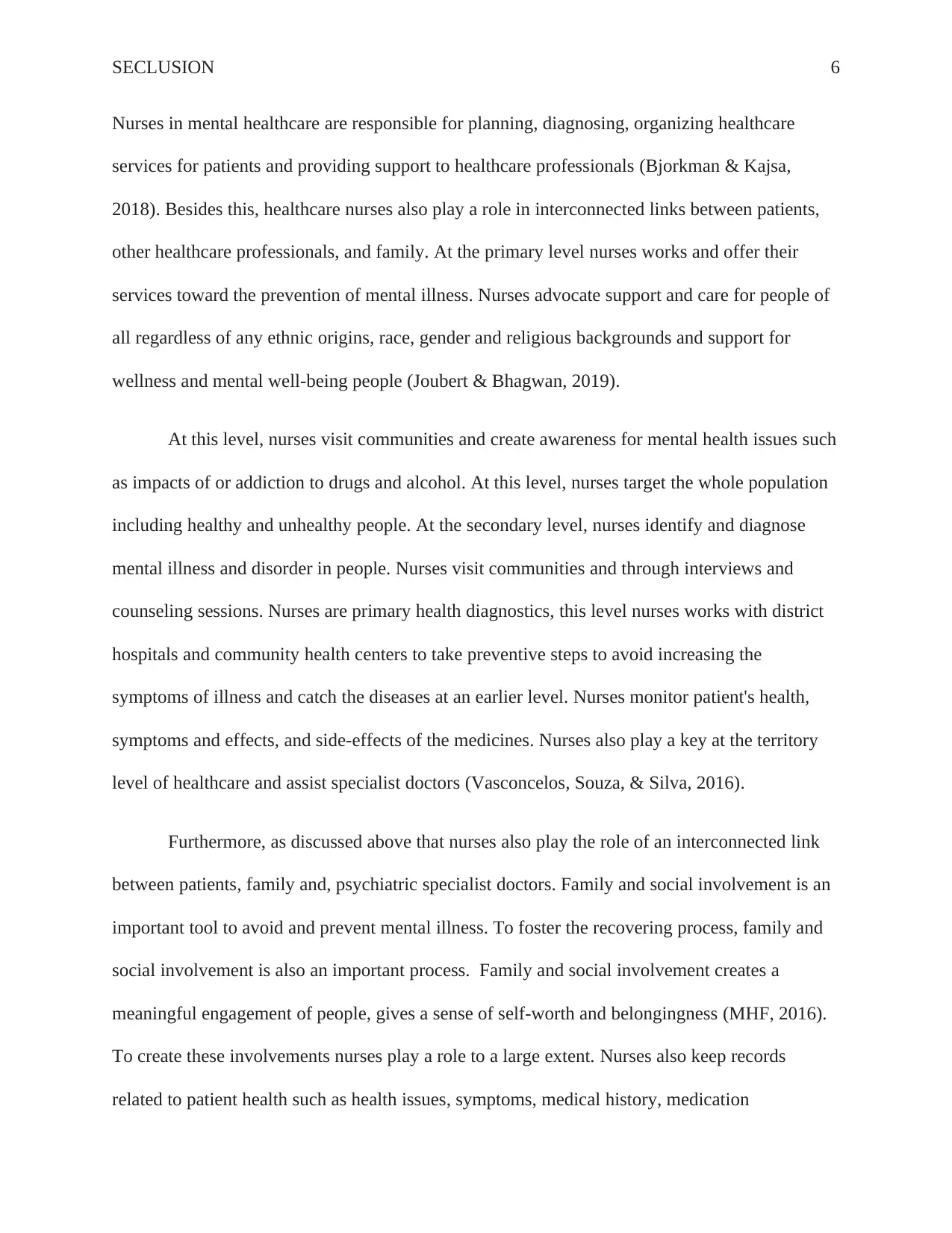
SECLUSION 6
Nurses in mental healthcare are responsible for planning, diagnosing, organizing healthcare
services for patients and providing support to healthcare professionals (Bjorkman & Kajsa,
2018). Besides this, healthcare nurses also play a role in interconnected links between patients,
other healthcare professionals, and family. At the primary level nurses works and offer their
services toward the prevention of mental illness. Nurses advocate support and care for people of
all regardless of any ethnic origins, race, gender and religious backgrounds and support for
wellness and mental well-being people (Joubert & Bhagwan, 2019).
At this level, nurses visit communities and create awareness for mental health issues such
as impacts of or addiction to drugs and alcohol. At this level, nurses target the whole population
including healthy and unhealthy people. At the secondary level, nurses identify and diagnose
mental illness and disorder in people. Nurses visit communities and through interviews and
counseling sessions. Nurses are primary health diagnostics, this level nurses works with district
hospitals and community health centers to take preventive steps to avoid increasing the
symptoms of illness and catch the diseases at an earlier level. Nurses monitor patient's health,
symptoms and effects, and side-effects of the medicines. Nurses also play a key at the territory
level of healthcare and assist specialist doctors (Vasconcelos, Souza, & Silva, 2016).
Furthermore, as discussed above that nurses also play the role of an interconnected link
between patients, family and, psychiatric specialist doctors. Family and social involvement is an
important tool to avoid and prevent mental illness. To foster the recovering process, family and
social involvement is also an important process. Family and social involvement creates a
meaningful engagement of people, gives a sense of self-worth and belongingness (MHF, 2016).
To create these involvements nurses play a role to a large extent. Nurses also keep records
related to patient health such as health issues, symptoms, medical history, medication
Nurses in mental healthcare are responsible for planning, diagnosing, organizing healthcare
services for patients and providing support to healthcare professionals (Bjorkman & Kajsa,
2018). Besides this, healthcare nurses also play a role in interconnected links between patients,
other healthcare professionals, and family. At the primary level nurses works and offer their
services toward the prevention of mental illness. Nurses advocate support and care for people of
all regardless of any ethnic origins, race, gender and religious backgrounds and support for
wellness and mental well-being people (Joubert & Bhagwan, 2019).
At this level, nurses visit communities and create awareness for mental health issues such
as impacts of or addiction to drugs and alcohol. At this level, nurses target the whole population
including healthy and unhealthy people. At the secondary level, nurses identify and diagnose
mental illness and disorder in people. Nurses visit communities and through interviews and
counseling sessions. Nurses are primary health diagnostics, this level nurses works with district
hospitals and community health centers to take preventive steps to avoid increasing the
symptoms of illness and catch the diseases at an earlier level. Nurses monitor patient's health,
symptoms and effects, and side-effects of the medicines. Nurses also play a key at the territory
level of healthcare and assist specialist doctors (Vasconcelos, Souza, & Silva, 2016).
Furthermore, as discussed above that nurses also play the role of an interconnected link
between patients, family and, psychiatric specialist doctors. Family and social involvement is an
important tool to avoid and prevent mental illness. To foster the recovering process, family and
social involvement is also an important process. Family and social involvement creates a
meaningful engagement of people, gives a sense of self-worth and belongingness (MHF, 2016).
To create these involvements nurses play a role to a large extent. Nurses also keep records
related to patient health such as health issues, symptoms, medical history, medication
Paraphrase This Document
Need a fresh take? Get an instant paraphrase of this document with our AI Paraphraser
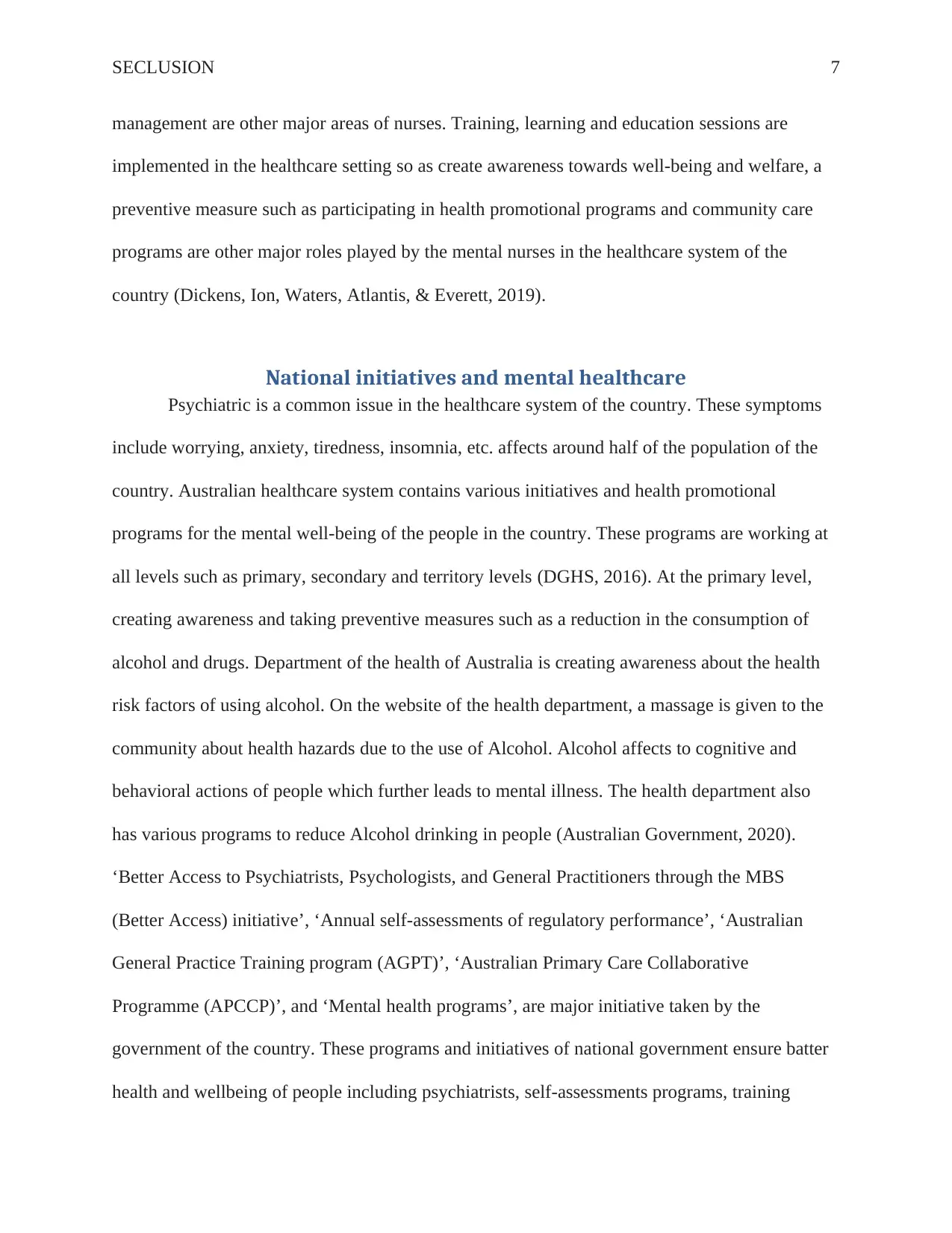
SECLUSION 7
management are other major areas of nurses. Training, learning and education sessions are
implemented in the healthcare setting so as create awareness towards well-being and welfare, a
preventive measure such as participating in health promotional programs and community care
programs are other major roles played by the mental nurses in the healthcare system of the
country (Dickens, Ion, Waters, Atlantis, & Everett, 2019).
National initiatives and mental healthcare
Psychiatric is a common issue in the healthcare system of the country. These symptoms
include worrying, anxiety, tiredness, insomnia, etc. affects around half of the population of the
country. Australian healthcare system contains various initiatives and health promotional
programs for the mental well-being of the people in the country. These programs are working at
all levels such as primary, secondary and territory levels (DGHS, 2016). At the primary level,
creating awareness and taking preventive measures such as a reduction in the consumption of
alcohol and drugs. Department of the health of Australia is creating awareness about the health
risk factors of using alcohol. On the website of the health department, a massage is given to the
community about health hazards due to the use of Alcohol. Alcohol affects to cognitive and
behavioral actions of people which further leads to mental illness. The health department also
has various programs to reduce Alcohol drinking in people (Australian Government, 2020).
‘Better Access to Psychiatrists, Psychologists, and General Practitioners through the MBS
(Better Access) initiative’, ‘Annual self-assessments of regulatory performance’, ‘Australian
General Practice Training program (AGPT)’, ‘Australian Primary Care Collaborative
Programme (APCCP)’, and ‘Mental health programs’, are major initiative taken by the
government of the country. These programs and initiatives of national government ensure batter
health and wellbeing of people including psychiatrists, self-assessments programs, training
management are other major areas of nurses. Training, learning and education sessions are
implemented in the healthcare setting so as create awareness towards well-being and welfare, a
preventive measure such as participating in health promotional programs and community care
programs are other major roles played by the mental nurses in the healthcare system of the
country (Dickens, Ion, Waters, Atlantis, & Everett, 2019).
National initiatives and mental healthcare
Psychiatric is a common issue in the healthcare system of the country. These symptoms
include worrying, anxiety, tiredness, insomnia, etc. affects around half of the population of the
country. Australian healthcare system contains various initiatives and health promotional
programs for the mental well-being of the people in the country. These programs are working at
all levels such as primary, secondary and territory levels (DGHS, 2016). At the primary level,
creating awareness and taking preventive measures such as a reduction in the consumption of
alcohol and drugs. Department of the health of Australia is creating awareness about the health
risk factors of using alcohol. On the website of the health department, a massage is given to the
community about health hazards due to the use of Alcohol. Alcohol affects to cognitive and
behavioral actions of people which further leads to mental illness. The health department also
has various programs to reduce Alcohol drinking in people (Australian Government, 2020).
‘Better Access to Psychiatrists, Psychologists, and General Practitioners through the MBS
(Better Access) initiative’, ‘Annual self-assessments of regulatory performance’, ‘Australian
General Practice Training program (AGPT)’, ‘Australian Primary Care Collaborative
Programme (APCCP)’, and ‘Mental health programs’, are major initiative taken by the
government of the country. These programs and initiatives of national government ensure batter
health and wellbeing of people including psychiatrists, self-assessments programs, training
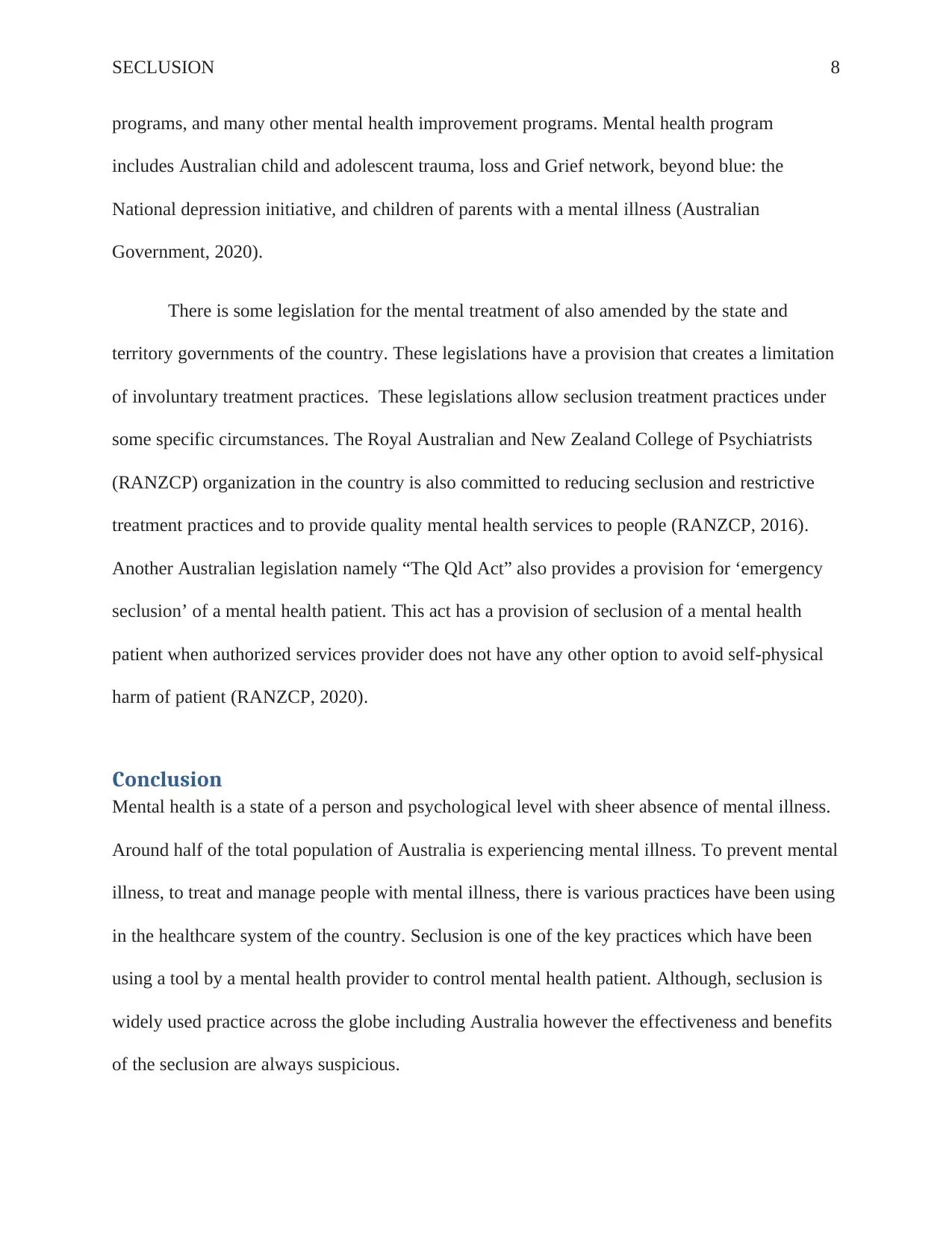
SECLUSION 8
programs, and many other mental health improvement programs. Mental health program
includes Australian child and adolescent trauma, loss and Grief network, beyond blue: the
National depression initiative, and children of parents with a mental illness (Australian
Government, 2020).
There is some legislation for the mental treatment of also amended by the state and
territory governments of the country. These legislations have a provision that creates a limitation
of involuntary treatment practices. These legislations allow seclusion treatment practices under
some specific circumstances. The Royal Australian and New Zealand College of Psychiatrists
(RANZCP) organization in the country is also committed to reducing seclusion and restrictive
treatment practices and to provide quality mental health services to people (RANZCP, 2016).
Another Australian legislation namely “The Qld Act” also provides a provision for ‘emergency
seclusion’ of a mental health patient. This act has a provision of seclusion of a mental health
patient when authorized services provider does not have any other option to avoid self-physical
harm of patient (RANZCP, 2020).
Conclusion
Mental health is a state of a person and psychological level with sheer absence of mental illness.
Around half of the total population of Australia is experiencing mental illness. To prevent mental
illness, to treat and manage people with mental illness, there is various practices have been using
in the healthcare system of the country. Seclusion is one of the key practices which have been
using a tool by a mental health provider to control mental health patient. Although, seclusion is
widely used practice across the globe including Australia however the effectiveness and benefits
of the seclusion are always suspicious.
programs, and many other mental health improvement programs. Mental health program
includes Australian child and adolescent trauma, loss and Grief network, beyond blue: the
National depression initiative, and children of parents with a mental illness (Australian
Government, 2020).
There is some legislation for the mental treatment of also amended by the state and
territory governments of the country. These legislations have a provision that creates a limitation
of involuntary treatment practices. These legislations allow seclusion treatment practices under
some specific circumstances. The Royal Australian and New Zealand College of Psychiatrists
(RANZCP) organization in the country is also committed to reducing seclusion and restrictive
treatment practices and to provide quality mental health services to people (RANZCP, 2016).
Another Australian legislation namely “The Qld Act” also provides a provision for ‘emergency
seclusion’ of a mental health patient. This act has a provision of seclusion of a mental health
patient when authorized services provider does not have any other option to avoid self-physical
harm of patient (RANZCP, 2020).
Conclusion
Mental health is a state of a person and psychological level with sheer absence of mental illness.
Around half of the total population of Australia is experiencing mental illness. To prevent mental
illness, to treat and manage people with mental illness, there is various practices have been using
in the healthcare system of the country. Seclusion is one of the key practices which have been
using a tool by a mental health provider to control mental health patient. Although, seclusion is
widely used practice across the globe including Australia however the effectiveness and benefits
of the seclusion are always suspicious.
⊘ This is a preview!⊘
Do you want full access?
Subscribe today to unlock all pages.

Trusted by 1+ million students worldwide
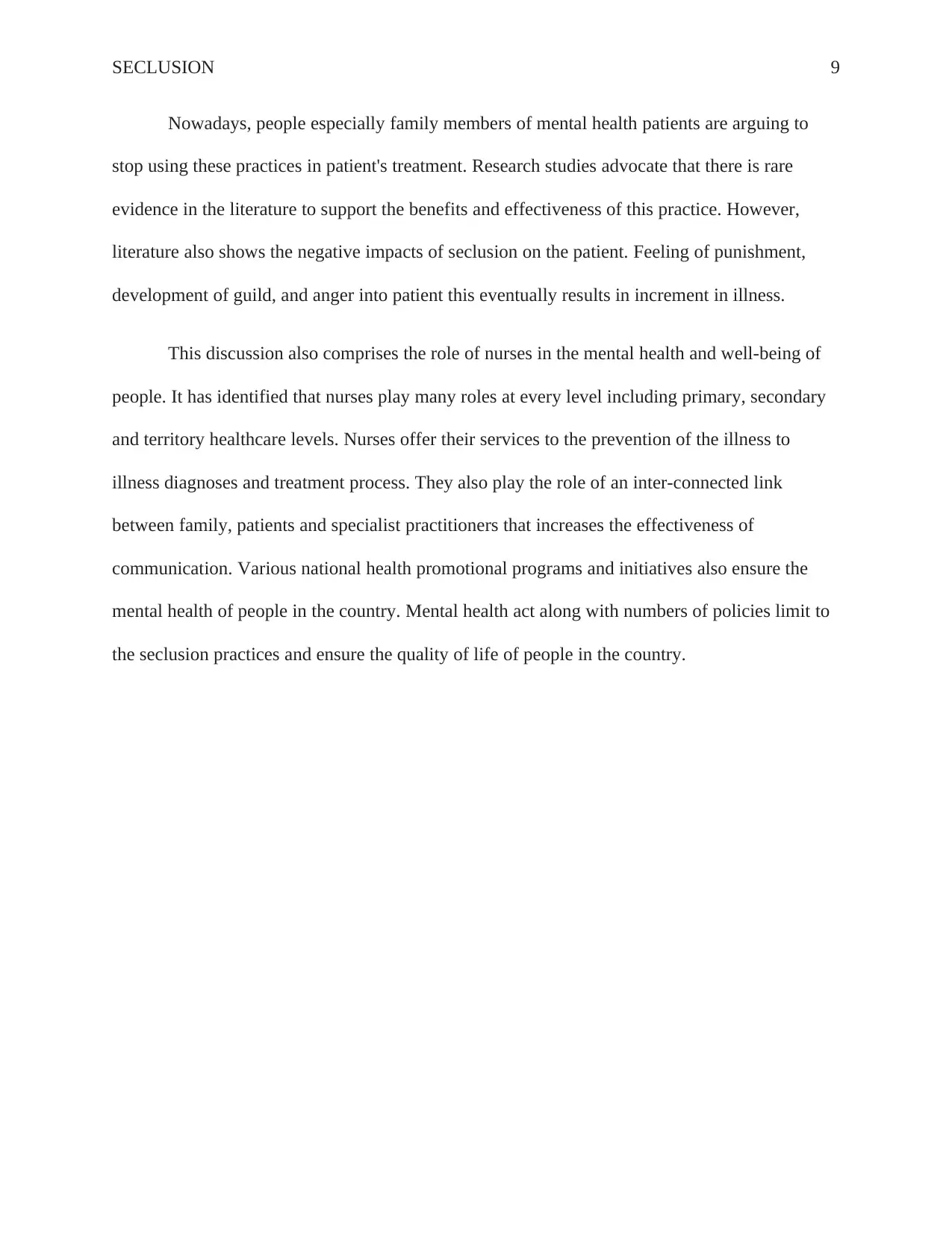
SECLUSION 9
Nowadays, people especially family members of mental health patients are arguing to
stop using these practices in patient's treatment. Research studies advocate that there is rare
evidence in the literature to support the benefits and effectiveness of this practice. However,
literature also shows the negative impacts of seclusion on the patient. Feeling of punishment,
development of guild, and anger into patient this eventually results in increment in illness.
This discussion also comprises the role of nurses in the mental health and well-being of
people. It has identified that nurses play many roles at every level including primary, secondary
and territory healthcare levels. Nurses offer their services to the prevention of the illness to
illness diagnoses and treatment process. They also play the role of an inter-connected link
between family, patients and specialist practitioners that increases the effectiveness of
communication. Various national health promotional programs and initiatives also ensure the
mental health of people in the country. Mental health act along with numbers of policies limit to
the seclusion practices and ensure the quality of life of people in the country.
Nowadays, people especially family members of mental health patients are arguing to
stop using these practices in patient's treatment. Research studies advocate that there is rare
evidence in the literature to support the benefits and effectiveness of this practice. However,
literature also shows the negative impacts of seclusion on the patient. Feeling of punishment,
development of guild, and anger into patient this eventually results in increment in illness.
This discussion also comprises the role of nurses in the mental health and well-being of
people. It has identified that nurses play many roles at every level including primary, secondary
and territory healthcare levels. Nurses offer their services to the prevention of the illness to
illness diagnoses and treatment process. They also play the role of an inter-connected link
between family, patients and specialist practitioners that increases the effectiveness of
communication. Various national health promotional programs and initiatives also ensure the
mental health of people in the country. Mental health act along with numbers of policies limit to
the seclusion practices and ensure the quality of life of people in the country.
Paraphrase This Document
Need a fresh take? Get an instant paraphrase of this document with our AI Paraphraser
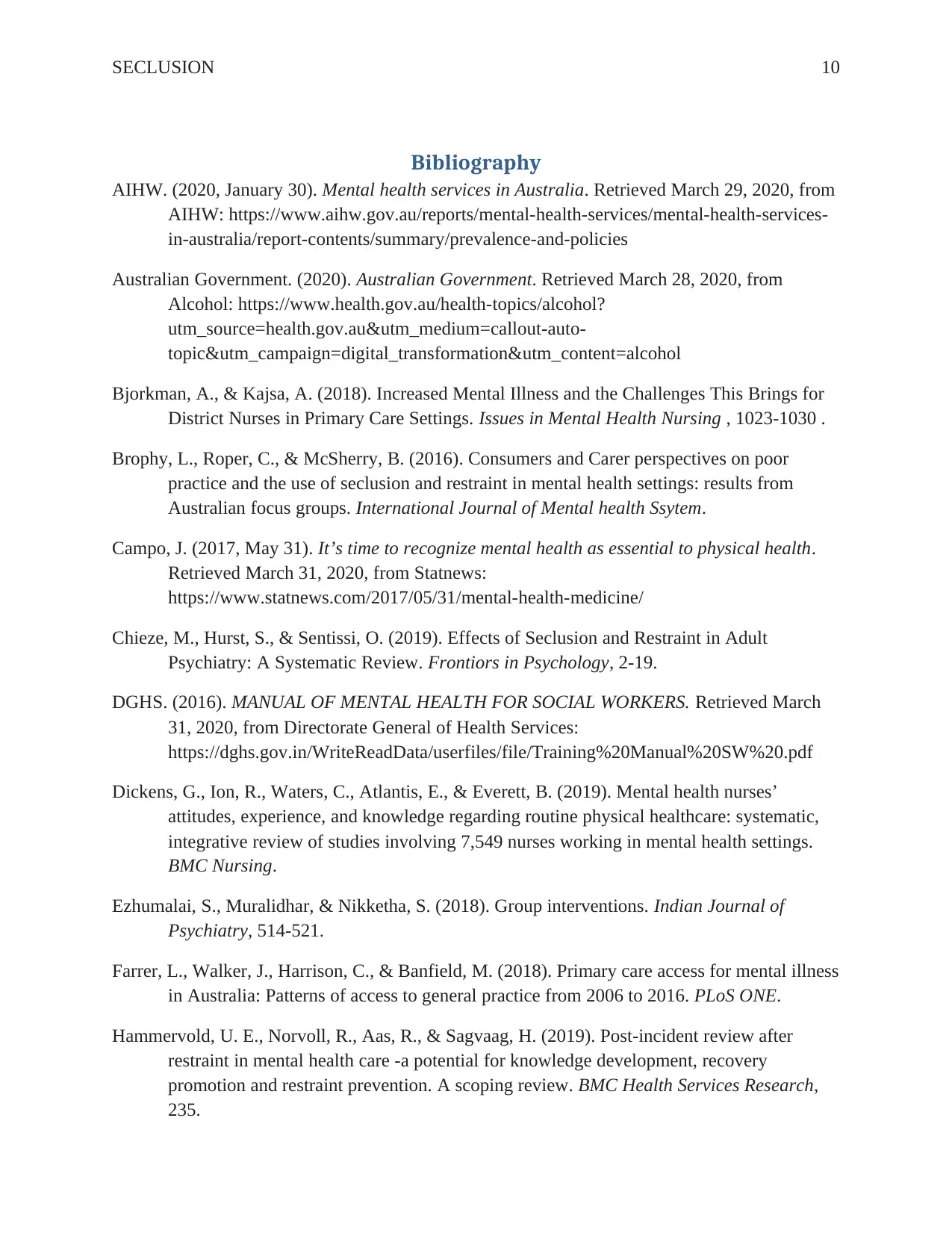
SECLUSION 10
Bibliography
AIHW. (2020, January 30). Mental health services in Australia. Retrieved March 29, 2020, from
AIHW: https://www.aihw.gov.au/reports/mental-health-services/mental-health-services-
in-australia/report-contents/summary/prevalence-and-policies
Australian Government. (2020). Australian Government. Retrieved March 28, 2020, from
Alcohol: https://www.health.gov.au/health-topics/alcohol?
utm_source=health.gov.au&utm_medium=callout-auto-
topic&utm_campaign=digital_transformation&utm_content=alcohol
Bjorkman, A., & Kajsa, A. (2018). Increased Mental Illness and the Challenges This Brings for
District Nurses in Primary Care Settings. Issues in Mental Health Nursing , 1023-1030 .
Brophy, L., Roper, C., & McSherry, B. (2016). Consumers and Carer perspectives on poor
practice and the use of seclusion and restraint in mental health settings: results from
Australian focus groups. International Journal of Mental health Ssytem.
Campo, J. (2017, May 31). It’s time to recognize mental health as essential to physical health.
Retrieved March 31, 2020, from Statnews:
https://www.statnews.com/2017/05/31/mental-health-medicine/
Chieze, M., Hurst, S., & Sentissi, O. (2019). Effects of Seclusion and Restraint in Adult
Psychiatry: A Systematic Review. Frontiors in Psychology, 2-19.
DGHS. (2016). MANUAL OF MENTAL HEALTH FOR SOCIAL WORKERS. Retrieved March
31, 2020, from Directorate General of Health Services:
https://dghs.gov.in/WriteReadData/userfiles/file/Training%20Manual%20SW%20.pdf
Dickens, G., Ion, R., Waters, C., Atlantis, E., & Everett, B. (2019). Mental health nurses’
attitudes, experience, and knowledge regarding routine physical healthcare: systematic,
integrative review of studies involving 7,549 nurses working in mental health settings.
BMC Nursing.
Ezhumalai, S., Muralidhar, & Nikketha, S. (2018). Group interventions. Indian Journal of
Psychiatry, 514-521.
Farrer, L., Walker, J., Harrison, C., & Banfield, M. (2018). Primary care access for mental illness
in Australia: Patterns of access to general practice from 2006 to 2016. PLoS ONE.
Hammervold, U. E., Norvoll, R., Aas, R., & Sagvaag, H. (2019). Post-incident review after
restraint in mental health care -a potential for knowledge development, recovery
promotion and restraint prevention. A scoping review. BMC Health Services Research,
235.
Bibliography
AIHW. (2020, January 30). Mental health services in Australia. Retrieved March 29, 2020, from
AIHW: https://www.aihw.gov.au/reports/mental-health-services/mental-health-services-
in-australia/report-contents/summary/prevalence-and-policies
Australian Government. (2020). Australian Government. Retrieved March 28, 2020, from
Alcohol: https://www.health.gov.au/health-topics/alcohol?
utm_source=health.gov.au&utm_medium=callout-auto-
topic&utm_campaign=digital_transformation&utm_content=alcohol
Bjorkman, A., & Kajsa, A. (2018). Increased Mental Illness and the Challenges This Brings for
District Nurses in Primary Care Settings. Issues in Mental Health Nursing , 1023-1030 .
Brophy, L., Roper, C., & McSherry, B. (2016). Consumers and Carer perspectives on poor
practice and the use of seclusion and restraint in mental health settings: results from
Australian focus groups. International Journal of Mental health Ssytem.
Campo, J. (2017, May 31). It’s time to recognize mental health as essential to physical health.
Retrieved March 31, 2020, from Statnews:
https://www.statnews.com/2017/05/31/mental-health-medicine/
Chieze, M., Hurst, S., & Sentissi, O. (2019). Effects of Seclusion and Restraint in Adult
Psychiatry: A Systematic Review. Frontiors in Psychology, 2-19.
DGHS. (2016). MANUAL OF MENTAL HEALTH FOR SOCIAL WORKERS. Retrieved March
31, 2020, from Directorate General of Health Services:
https://dghs.gov.in/WriteReadData/userfiles/file/Training%20Manual%20SW%20.pdf
Dickens, G., Ion, R., Waters, C., Atlantis, E., & Everett, B. (2019). Mental health nurses’
attitudes, experience, and knowledge regarding routine physical healthcare: systematic,
integrative review of studies involving 7,549 nurses working in mental health settings.
BMC Nursing.
Ezhumalai, S., Muralidhar, & Nikketha, S. (2018). Group interventions. Indian Journal of
Psychiatry, 514-521.
Farrer, L., Walker, J., Harrison, C., & Banfield, M. (2018). Primary care access for mental illness
in Australia: Patterns of access to general practice from 2006 to 2016. PLoS ONE.
Hammervold, U. E., Norvoll, R., Aas, R., & Sagvaag, H. (2019). Post-incident review after
restraint in mental health care -a potential for knowledge development, recovery
promotion and restraint prevention. A scoping review. BMC Health Services Research,
235.
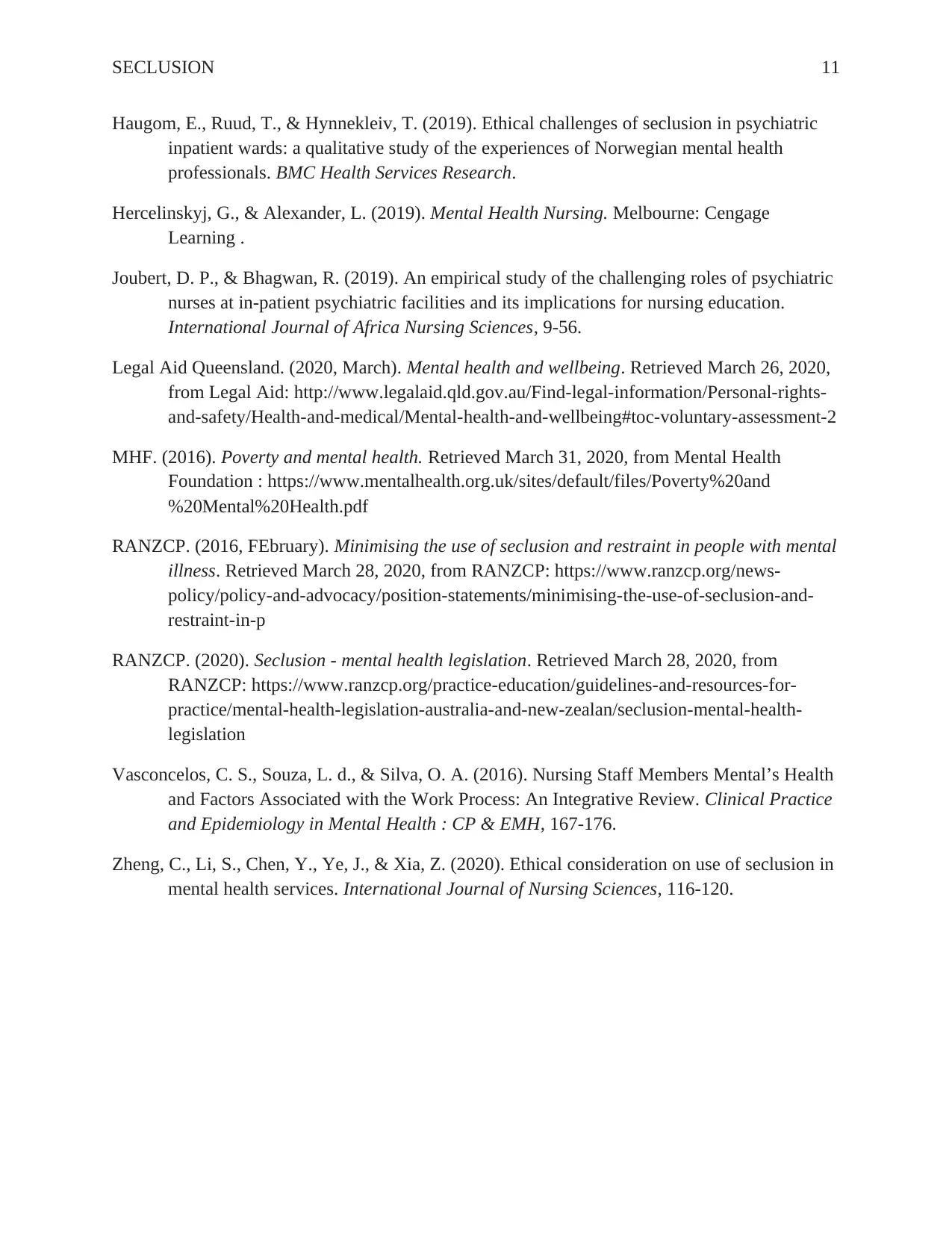
SECLUSION 11
Haugom, E., Ruud, T., & Hynnekleiv, T. (2019). Ethical challenges of seclusion in psychiatric
inpatient wards: a qualitative study of the experiences of Norwegian mental health
professionals. BMC Health Services Research.
Hercelinskyj, G., & Alexander, L. (2019). Mental Health Nursing. Melbourne: Cengage
Learning .
Joubert, D. P., & Bhagwan, R. (2019). An empirical study of the challenging roles of psychiatric
nurses at in-patient psychiatric facilities and its implications for nursing education.
International Journal of Africa Nursing Sciences, 9-56.
Legal Aid Queensland. (2020, March). Mental health and wellbeing. Retrieved March 26, 2020,
from Legal Aid: http://www.legalaid.qld.gov.au/Find-legal-information/Personal-rights-
and-safety/Health-and-medical/Mental-health-and-wellbeing#toc-voluntary-assessment-2
MHF. (2016). Poverty and mental health. Retrieved March 31, 2020, from Mental Health
Foundation : https://www.mentalhealth.org.uk/sites/default/files/Poverty%20and
%20Mental%20Health.pdf
RANZCP. (2016, FEbruary). Minimising the use of seclusion and restraint in people with mental
illness. Retrieved March 28, 2020, from RANZCP: https://www.ranzcp.org/news-
policy/policy-and-advocacy/position-statements/minimising-the-use-of-seclusion-and-
restraint-in-p
RANZCP. (2020). Seclusion - mental health legislation. Retrieved March 28, 2020, from
RANZCP: https://www.ranzcp.org/practice-education/guidelines-and-resources-for-
practice/mental-health-legislation-australia-and-new-zealan/seclusion-mental-health-
legislation
Vasconcelos, C. S., Souza, L. d., & Silva, O. A. (2016). Nursing Staff Members Mental’s Health
and Factors Associated with the Work Process: An Integrative Review. Clinical Practice
and Epidemiology in Mental Health : CP & EMH, 167-176.
Zheng, C., Li, S., Chen, Y., Ye, J., & Xia, Z. (2020). Ethical consideration on use of seclusion in
mental health services. International Journal of Nursing Sciences, 116-120.
Haugom, E., Ruud, T., & Hynnekleiv, T. (2019). Ethical challenges of seclusion in psychiatric
inpatient wards: a qualitative study of the experiences of Norwegian mental health
professionals. BMC Health Services Research.
Hercelinskyj, G., & Alexander, L. (2019). Mental Health Nursing. Melbourne: Cengage
Learning .
Joubert, D. P., & Bhagwan, R. (2019). An empirical study of the challenging roles of psychiatric
nurses at in-patient psychiatric facilities and its implications for nursing education.
International Journal of Africa Nursing Sciences, 9-56.
Legal Aid Queensland. (2020, March). Mental health and wellbeing. Retrieved March 26, 2020,
from Legal Aid: http://www.legalaid.qld.gov.au/Find-legal-information/Personal-rights-
and-safety/Health-and-medical/Mental-health-and-wellbeing#toc-voluntary-assessment-2
MHF. (2016). Poverty and mental health. Retrieved March 31, 2020, from Mental Health
Foundation : https://www.mentalhealth.org.uk/sites/default/files/Poverty%20and
%20Mental%20Health.pdf
RANZCP. (2016, FEbruary). Minimising the use of seclusion and restraint in people with mental
illness. Retrieved March 28, 2020, from RANZCP: https://www.ranzcp.org/news-
policy/policy-and-advocacy/position-statements/minimising-the-use-of-seclusion-and-
restraint-in-p
RANZCP. (2020). Seclusion - mental health legislation. Retrieved March 28, 2020, from
RANZCP: https://www.ranzcp.org/practice-education/guidelines-and-resources-for-
practice/mental-health-legislation-australia-and-new-zealan/seclusion-mental-health-
legislation
Vasconcelos, C. S., Souza, L. d., & Silva, O. A. (2016). Nursing Staff Members Mental’s Health
and Factors Associated with the Work Process: An Integrative Review. Clinical Practice
and Epidemiology in Mental Health : CP & EMH, 167-176.
Zheng, C., Li, S., Chen, Y., Ye, J., & Xia, Z. (2020). Ethical consideration on use of seclusion in
mental health services. International Journal of Nursing Sciences, 116-120.
⊘ This is a preview!⊘
Do you want full access?
Subscribe today to unlock all pages.

Trusted by 1+ million students worldwide
1 out of 12
Related Documents
Your All-in-One AI-Powered Toolkit for Academic Success.
+13062052269
info@desklib.com
Available 24*7 on WhatsApp / Email
![[object Object]](/_next/static/media/star-bottom.7253800d.svg)
Unlock your academic potential
Copyright © 2020–2025 A2Z Services. All Rights Reserved. Developed and managed by ZUCOL.





